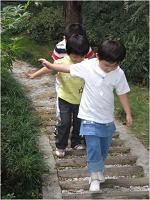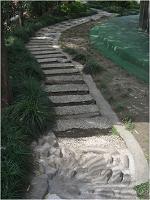A kindergarten environment that supports child development should not be created based on the expectations or unfounded imagination of adults. Creating educational kindergarten environments suitable for children requires focusing on children, understanding their interests and likes, listening to their hearts and grasping the nature of their cognition.

Kindergarten affiliated with Hangzhou College of Preschool Teacher Education
In the present research, we clarify some problems in color design, spatial design, and theme activity design that are suitable for children from the perspective of children's color preference, spatial cognition and curiosity.
Creating suitable environments for child development is the basic starting point of education. According to John Dewey, "Educators are primarily required not to only understand general principles of child development by observing actual experience under various environmental conditions, but also to recognize what kind of environment actually contributes to creating experiences that lead to growth. Above all, they should know how to utilize existing physical and social conditions, and extract from them conditions or environments that can help children to have valuable experiences."
According to situated learning theory, children acquire knowledge and skills through practical activities in specific contexts rather than through abstract logic or symbols as do adults. Learners cannot understand the meaning and value of knowledge unless they learn them in real situations. Neural constructivist theory asserts that while the development of progressive complexity in the cerebral cortex is due to the genetic code of neurons, stimulation from outside the nervous system and competitive characteristics of proximal areas in cerebral cortex are more important.
To create an environment suitable for educating the young child, we should first consider the interests, likes, needs, feelings, and individuality of children.
Today, we will discuss three problems as follows:
- What characterizes the colors that children like? How should we create a color world for children?
- What characterizes the spaces that children like? How should we create a spatial world for children?
- What kind of activities do children like? How should we create the environment for theme activities?
- What characterizes the colors that children like? How should we create a color world for children?
Study 1
27 4-year-old children, coloring a picture of a butterfly
- 86% used red, yellow, green, light blue, pink or orange.
- 14% used navy blue, purple, dark brown or brown.
- None used black, gray or white.
Study 2
20 2-3-year-old children, free line drawing with color pens
- 80% used red, yellow or green.
- 20% used pink or blue.
- None used black or grey.
Study 3
Li Chen & Ansheng Wang (1965) studied the order of color preference in adults and pre-school children.
- Order of preference in pre-school children: red, blue, green, yellow
- Order of preference in adults: blue, red, green, purple, orange, yellow
Study 4
German psychologists have found that children become happy, cheerful and lively in light blue, light yellow, light green or red orange surroundings. In contrast, they become easily tired, anxious and depressed in black, black-brown, grey, or white surroundings.

Photo 1: Adjust colors to create similar or contrasting effects
Color design
- Decide the kindergarten's main colors according to children's color preference. These main colors can be used in the kindergarten's parapet wall, outer wall, inner wall, toys, flooring, curtains, and outdoor grounds.
- Adjust colors to create similar or contrasting effects.
- Make good use of the ability of colors to convey temperature, distance, etc., based on the physiological and psychological reaction to colors. --- Photo 1
- What characterizes the spaces that children like? How should we create a spatial world for children?
- Children like multi-level, three-dimensional, varied spaces
We designed an activity room and a multi-level napping room from the child's point of view. We also created a reading area in the baby room that emphasized the three-dimensional effect of the space. Using movable beds, chests, bookshelves and easels enhanced the versatility and varied nature of the spaces. --- Photo 2
Photo 2: Reading area (children like multi-level, three-dimensional, varied spaces) - Children like interesting and challenging spaces
We designed a two-level activity room, a napping room and easels where children can hide to make the space more interesting and fun. Children like bumpy roads, so we used triangular wooden sticks or bark, cobblestones, and smooth china fragments to make a bumpy road. This was intended not only to satisfy children's need for adventure and challenges, but also to promote circulation in the soles of the feet and sensory development. --- Photo 3, 4
 Photo 3: Two-level napping room (Screen design allows hide-and-seek and stimulates curiosity.) |
  Photo 4: Bumpy road (Adventurous children choose bumpy roads over smooth ones. Walking on bumpy roads promotes blood circulation in the soles of the feet and sensory development.) |
- Children need spaces for privacy
Given that children 4-5 years old already have secrets, we designed an "emotion space" on a separate level" and a "secret house" for them to release feelings or communicate with friends. --- Photo 5

Photo 5: Secret house where children can have confidential talk
- Children love nature
To satisfy children's need to explore nature, we designed outside spaces full of free-wheeling fun, such as a rocky area, plant garden, sandy area, animal house and so forth. --- Photo 6, 7

Photo 6: Outside space made of natural materials
Photo 7: Animal house
- What kind of activities do children like? How should we create the environment for theme activities?
Children have a strong desire for autonomy. They like playing different roles in different situations, and have strong urge for self-expression and imitation. Theme activities not only evoke interest but also satisfy the desire to explore.
- Make full use of walls in theme activities. Make walls come alive by making them movable and changeable so that children can interact with the walls or activities recorded on the walls to evoke autonomous exploration. We use also walls to show the aim of the theme activity to the children. Additionally, we make the wall a place for children to express themselves.
- Create a vibrant environment full of energy, enhance the theme ambience, and motivate children to participate and explore themes. We let children enter designed real-world situations to motivate autonomous exploration. We ask children to act out different roles in the situation to promote their social development. --- Photo 8

Photo 8: Child supermarket (for play shopping)














